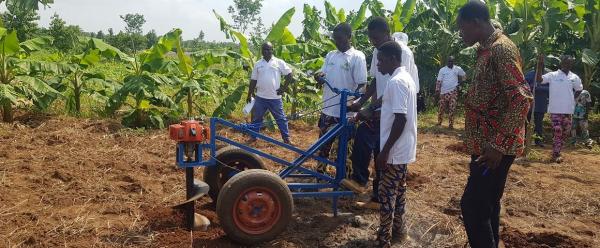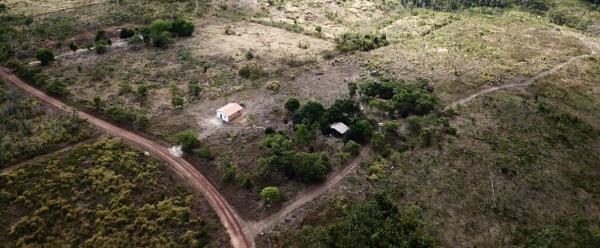Call to action 25 November 2025
- Home
- CIRAD news
- News
- Betting on legumes for food security in Africa
Food security in Africa: growing legumes to reduce the need for mineral fertilizers?

Groundnut plot in Ndiob, Senegal, where the legume is often grown in rotation with millet or sorghum © R. Belmin, CIRAD
Ending hunger by 2030 is one of the Sustainable Development Goals set by the UN. This is a huge challenge in sub-Saharan Africa, where one third of all households are still exposed to food insecurity. To meet the demand of the rapidly growing African population, the need to substantially increase cereal crop yields is widely acknowledged.
These crop yields are severely limited in the region by the depletion of soil nutrients after decades of continuous cropping with insufficient fertilization, itself resulting from inadequate use of mineral fertilizers and a lack of biomass available for organic fertilization.
Currently, the quantity of nitrogen input would need to increase 15-fold to reach a cereal crop yield compatible with food security.
The precious nutrients in green manure
Mineral fertilizers are one means of increasing nitrogen availability for crops. Although they are crucial for improving cereal crop yields, they can nevertheless harm the environment in case of excessive use, and are often too expensive for farmers, with the global market turmoil linked to the war in Ukraine having increased this constraint.
Nitrogen is abundant in the atmosphere and legumes have the unique ability to fix this atmospheric nitrogen in their plant tissues via symbiotic bacteria. Growing legumes before cereals and digging their residues into the soil before sowing could provide soils with substantial nitrogen inputs and optimize the use of mineral fertilizers needed to improve cereal crop yields.
This effect is well known in temperate and tropical systems, but can vary considerably from one year to another. With an increase in temperature, legume residues will decompose more rapidly, whereas in the case of heavy rains, the nitrogen obtained by residue decomposition could be lost to the crop due to leaching.
Fertilizers, climate and rice growth in Madagascar
For more than 20 years, FOFIFA (institute of agronomic research in Madagascar) and CIRAD have been exploring different avenues aimed at sustainably intensifying agricultural production in Madagascar and increasing household income.
In this recent study, we explored the potential of replacing some of the mineral fertilizers used to increase yields with green manure for rainfed rice production in Madagascar. The General Policy of the State in Madagascar provides for an increase in rice production in order to ensure food self-sufficiency in the country.
The saturation of the floodplains where irrigated rice is grown, and the development and recent dissemination of varieties adapted to higher altitudes, have resulted in the rapid expansion of rainfed rice cultivation in Madagascar’s highlands: in 2011, 71% of farmers were growing rainfed rice.
However, they currently obtain an average yield of 1.6 t/ha, which is well below the maximum yield of around 4 to 6 t/ha that can be obtained in research stations under experimental conditions, in other words when nutrients are not limited and when pests – insects, diseases, weeds – are controlled.
Mucuna and Crotalaria
In our experiment, the green manure grown was a combination of “Mucuna” and “Crotalaria” legumes. Thanks to their complementary growth and aboveground structures, these two plants can produce a large quantity of plant biomass and thereby fix atmospheric nitrogen. This green manure was grown during the rainy season in the first year of a two-year rotation based on rainfed rice, and residues were then incorporated into the soil, before tillage and rice sowing for the following crop season.
The rotation was repeated twice for the purposes of the experiment and compared to rice monoculture. We conducted in-depth monitoring of this experiment, measuring the quantity of nitrogen in soil and plants, the dynamics of rice growth, the biomass produced and the grain yield. The data collected enabled us to adapt a crop simulation model to the case of rainfed rice in Madagascar, in order to reproduce the impact of green manure incorporation and decomposition on rice growth.
A promising model
The model then enabled us to explore the potential advantages of green manure for rice growth, for 24 hypothetical rice growing seasons, built using climate measurements corresponding to our study region, for the period from 1994 to 2018. In this virtual experiment, we set the quantity of green manure incorporated into the soil prior to rice cultivation at 6 t/ha (or 140 kg of nitrogen), based on results obtained in the field.
Our findings showed that the cultivation and integration of green manure made it possible to reduce the mineral fertilizers required to improve rice yields. We set the target yield at 3.7 t/ha, or 75% of the maximum yield obtained in the on-station experiments. This reference yield was achieved with 40 kg/ha of nitrogen provided by mineral fertilizers when green manure was added to the soil. By way of comparison, more than double this quantity or 100 kg/ha, was necessary without the use of green manure.
Trade-offs to be made
This promising practice nevertheless requires considerable adjustments to enable its implementation on family farms in Madagascar. Three key aspects need to be taken into consideration.
First, in years with heavy rainfall, the benefits of green manure on rice productivity are not observed: the additional nitrogen provided by green manure decomposition is no longer available for rice because of leaching. This therefore calls for dynamic management of residues and fertilizers, as well as technical advice to adapt inputs to crop requirements.
Next, the increase in rice productivity enabled by green manure does not entirely offset the rice yield loss due to the cultivation of this manure. If farmers want to grow green manure, they have to use some of their land for this crop – land that would otherwise be used to grow rice for household food self-sufficiency. Incentive mechanisms could be implemented to offset this loss, because the cultivation of these manures in rotation can provide a number of important services (better control of pests, nematodes and weeds, higher soil fertility over time, biodiversity maintenance).
Finally, crop residues are typically left on the land to be grazed by cattle in the region. Alternative solutions are therefore required to feed cattle, and suitable value chains need to be developed to guarantee supplies for these farmers, who often live a long way from any infrastructure. It is also essential to once again ensure that mechanisms exist to offset this additional spending for farms, the majority of which live on less than 540 euros per year per agricultural worker.
Dual purpose legumes
The constraint linked to rainfall can be overcome by adjusting the date of green manure incorporation and the date of rice sowing in order to better synchronize green manure decomposition and crop growth. The model that we have calibrated can help to make this type of assessment in silico.
The loss of food production due to green manure production could be partially offset by growing a pulse crop that provides food for farmers (for example groundnuts) along with the green manure. Experiments in Southern Africa are currently focusing on the assessment of these “dual” legume crop rotations.
However, it is important to ensure a market exists for these products with a sufficiently high price. Finally, the cultivation of dual purpose legumes (producing both pulses and forage) could be one of the key elements of the trade-off required to improve soil fertility and provide forage.
Time is short, but we are convinced that a change can occur rapidly to transform the current cereal production system towards greater productivity and sustainability. Solutions exist, including green manure, but extension officers, researchers, value chain actors and policymakers need to help farmers to invest in these techniques that will maximize production in the short term, but will be more sustainable in the long term.
The original version of this article was published in French on The Conversation , on 27 April 2023.



























